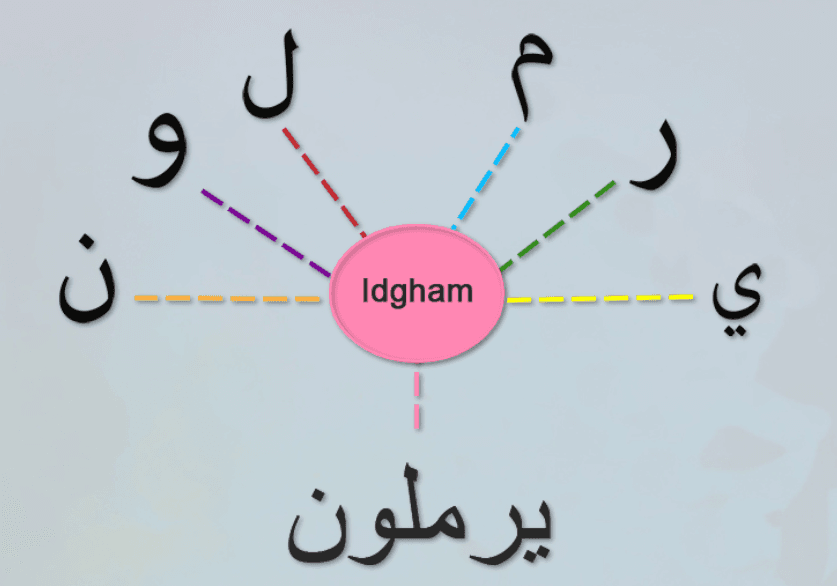idgham rule is one of the most important rules of Tajweed, which means insertion, and it is the custom of the Arabs to use it in their ordinary speech. It is not only one of the provisions specific to the recitation of the Noble Qur’an, such as the qalqalah and the mudd.
Rather, idgham rules are present in the speech of the Arabs, because of the ease and ease of pronunciation in it, and the one who contemplates our colloquial speech will find We use rules of idgham without realizing or noticing it. In this article, tajweed rules idgham will be defined linguistically and idiomatically, and some of its sections will be explained.
What is the definition of idgham rule?
The definition of idgham rule in the language is: inserting something into something, and in terminology: it is the joining of a consonant letter with a vowel letter that follows it so that when reading they become one stressed letter.

The tongue raises one height when pronouncing them with the weight of two letters, and idgham rules occurs in six letters, which are: the ya’, the ra’, The meem, lam, waw, and nun have been combined with the word يرملون to make it easier for students to memorize.
In order for the rules of idgham to take place, it is required that these letters fall at the beginning of a word, and the word before it ends with a noon sakinah or tanween, and the noon sakinah or tanween is called an tajweed rules idgham.
And the six letters in it are assimilated, except for some verses that departed from this rule in consideration of the narration that was transmitted from the Messenger – Peace be upon him.
Types of idgham rule
After we have defined idgham rule linguistically and idiomatically, we must clarify the types of idgham rule. There are different types of idgham rules in the language that are used in intonation according to the type of letter. The most important of these types are the following:
1-Idgham of the noon sakinah or tanween
idgham rule of the tanween is by inserting the sakina nun into the letter that follows it so that it becomes one letter when it is pronounced and heard, but it becomes of the same type as the second letter that is present in the word.

2-Idgham with ghana
It is a type of idgham rule that appears when one hears the ghanna in the amount of two vowels, and it is found in four letters that can be combined into one word, which is “يرملون.”
3-Idgham without ghunnah
It is a type of rules of idghaam in which no ghana appears and is only found in two letters only, namely the rā’ and the letter lām.
4-Idgham kamil
In this type of rules of idgham, all the characteristics related to the assimilated letter disappear, and the letters in which complete assimilation occurs are the letter Nun, the letter M, the letter Ra, and the letter L.
5-Idgham naqis
In this type of rules of idgham, the letter itself disappears, but its characteristics remain, which are represented by the ghannah. This type of assimilation is found in two letters: the letter yaa and the letter waw.
6-idgham of the sakina meem
In the case of tajweed rules idgham of the sakina meem, there is another meem behind it, so the first is assimilated with the second to become one stressed letter. In this case, the ghunna appears in it during two vowels.
In this case, it is called oral assimilation because the pronunciation emerges from the lips, and this is what distinguishes it from the assimilation of the sakina nūn.
It is also called idgham mithlin sagirin, and it is called that because the first letter combined with the second looks exactly like it, and it is called small because the meem in its first state is consonant, while in the second state it is vowel.
What are the causes of tajweed rules idgham?
There are three reasons for tajweed rules idgham:
- Similarity: the agreement of the two letters in the form and adjective, meaning that they are one letter repeated, such as the ba with the ba in the Almighty’s saying: (اضْرِب بِّعَصَاكَ).
- Homogeneity: the two letters agree in a way out and differ in their characteristics, such as the tha’ in dhaal in His saying – the Most High -: (يَلهَث ذلِكَ).
- Proximity: The two letters are far apart in form or adjective, or they are close together in form or adjective, such as: (وَقُل رَّبِّ أَنزِلْنِي).
Contraindications to rules of idgham
idgham rule is prohibited despite the existence of its reasons in three cases, as follows:
- If the first letter ta is the first person pronoun; Such as Allah Almighty saying: (كُنتُ تُرَابًا), or if the first letter is ta’, the second person pronoun; As Allah Almighty says: (أَفَأَنتَ تُسْمِعُ)
- If the first letter is stressed, it is pronounced with two sounds, so there is no need to assimilate it, as Allah Almighty says: (مَسَّ سَقَرَ).
- If the first letter is a manoun, like the Almighty’s saying: (سارِبٌ بِالنَّهارِ).
idgham rule and the provisions of the Noon Sakinah and Tanween
idgham rule is one of the rulings on the nun sakinah and tanween. The presence of the idgham rule is associated with the presence of the nun sakinah or tanween, and is negated by its absence. In this case, it has special letters that the scholars have combined into one word, which is (يرملون).
Accordingly, the letters of idgham rule, considering it one of the rulings on the nun sakinah and tanween, are: : Ya, Ra, M, Lam, W, and Nun. In order for the ruling to be complete.
It is stipulated that the sukoon-nun be at the end of the first word, and the idgham rule letter at the beginning of the second word. In this case, the letter nun or tanween is called assimilated, and the assimilation letter is called idgham rules.
idgham rules and rulings on the meem sakinah
tajweed rules idgham has rulings that are associated with the noon saukah or tanween, and it is also one of the rulings that are associated with the meem saukah.
If a silent meem comes and a vowel meem comes after it; The reader must combine the silent meem with the moving meem, and the silent meem is a meem devoid of all vowels, and thus the condition of the meem in stopping and connecting is equal.
The provisions of the silent meem do not apply to the vowelized meem, the stressed meme, or the occasional silent meem. Such as pausing on the meem that is at the end of a word, or the silent meem that has been moved to prevent two silent ones from meeting.
These meems fall outside the rulings on the silent meem, and do not result in a ruling on them. Because there is no silence in it. As for the idgham rule letter, as it is considered one of the rulings of the silent meem, it is the letter meem only.
So the silent meem that comes at the end of the first word is assimilated into the vowel meem at the beginning of the second word with a ghunna given, and this type of idgham rule is called the assimilation of the two small proverbs; Because it occurs for two letters that are united in the noun and the adjective.
Which are the consonant meem and the vowel meem, and it is also called the small assimilation; Because it occurs between a consonant meem and a vowel meme, it is also called oral assimilation. Because the meem is produced by the lips, which is a way to distinguish it from the assimilation of the consonant nūn into its letters.
General warnings regarding Idgham
After completing the definition of idgham rules linguistically and terminologically and explaining some of its details, it is necessary to point out some warnings and general matters related to idgham rules, including:
- rules of idgham do not occur in a single word in order to preserve the pronunciation of the word and its meaning.
- The consonant nūn combined with the assimilation letters in four words of the Holy Qur’an, which are sunan, qanwan, banyan, and the world.
- The nūn was not assimilated with the letter that follows it, because this merging leads to a defect in the meaning and pronunciation. This condition is called Absolute.
- Tanween is attached to the noon saakinah in the rules of idgham and is not attached to the meem sakinah. This is because tanween is originally a noun sakanah and not a meem.
- The amount of ghunna in the idgham rules is two vowels.
- The sign of complete assimilation is that the first letter is stripped of the vowel and the letter that follows it is stressed, and the tanween is sequential.
- As for the sign of incomplete assimilation, the letters are stripped of the vowel and the tanween is superimposed.
- idgham rules of a silent meem is a complete assimilation.
Conclusion
At the end of the text, idgham rule is defined linguistically as rapprochement. In terminology, it is the insertion of a vowel letter into a consonant letter. The reason for insertion is often the closeness of the letters’ exits to each other.
In addition to that, we mentioned the reasons for tajweed rules idgham in detail, as well as some other cases in which it is prohibited to apply the idgham rule.As well as some precautions that you should consider when applying the idgham rules.
